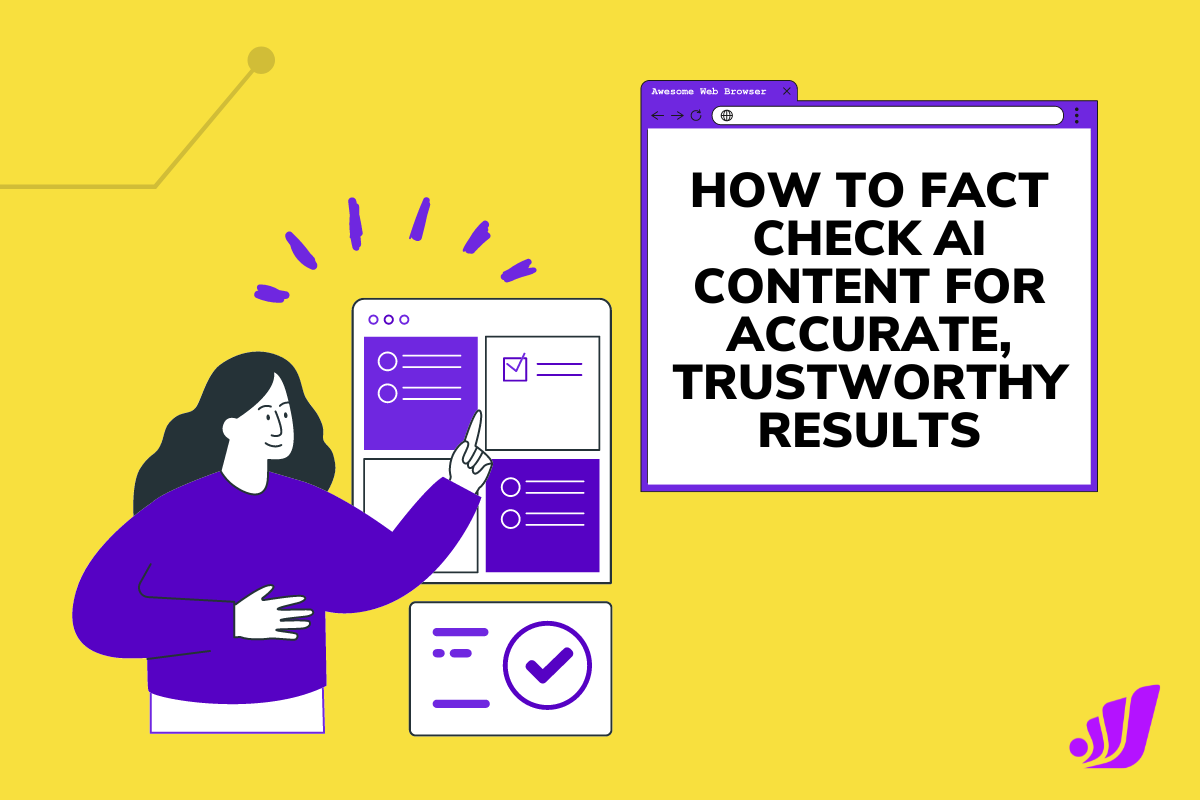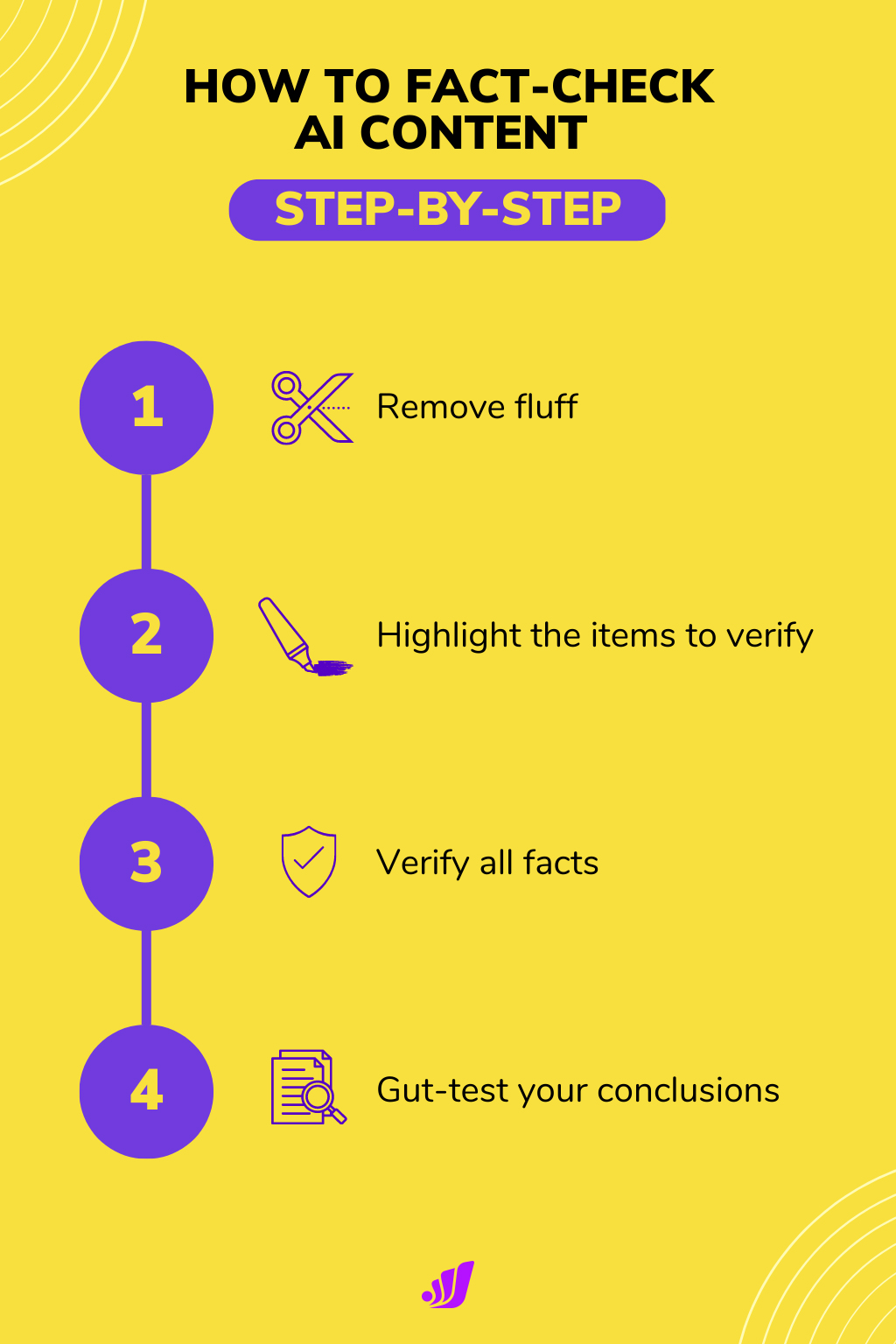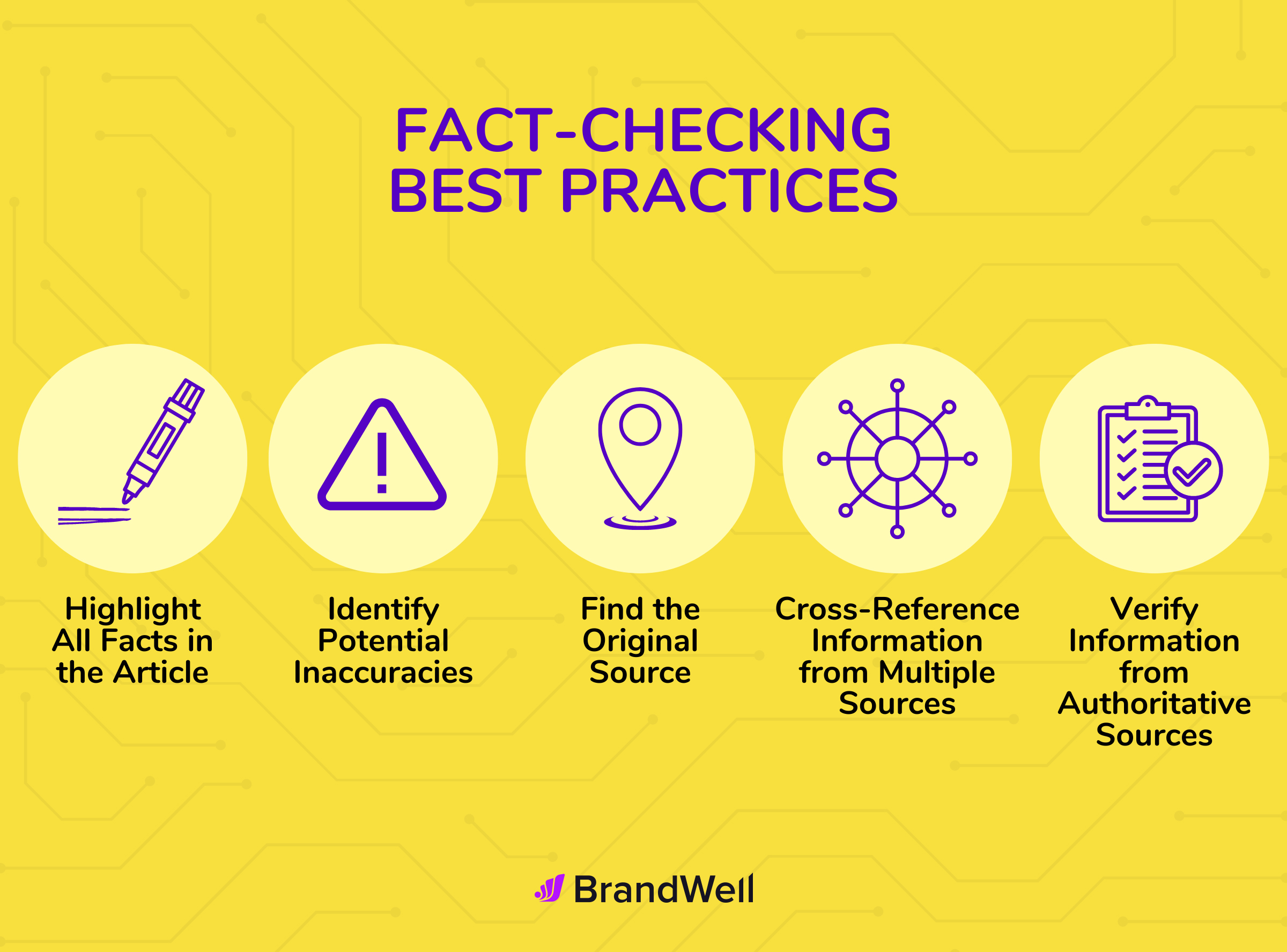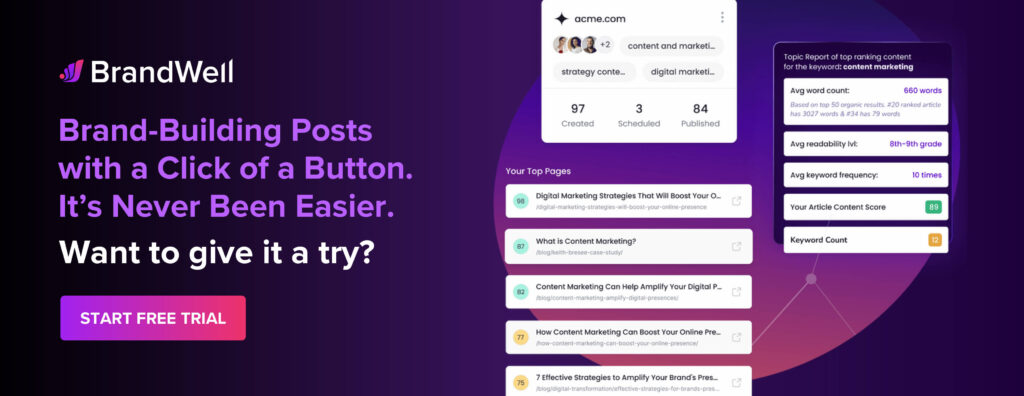Discover top guides, trends, tips and expertise from AIO Writers
How to Fact-Check AI Content for Accurate, Trustworthy Results
Julia McCoy
Wednesday, 14th Jun 2023
By now we know that AI doesn’t always get its facts straight. It is known to “hallucinate” or make up information that isn’t true.
That said, from what I’ve seen, BrandWell tends to produce solid outputs, though like any AI, it can sometimes get facts wrong. That’s why fact-checking is still essential.
However, it’s not perfect. No tool is. That’s why making sure to fact-check AI content is super important.
It might take you a minute to do but it’s a minute well spent.
Fact-checking ensures that you’re delivering accurate, true, and trustworthy information to your readers — and all of that builds trust.
Sharing true information will build authority. It will build your reputation.
Sharing false information, on the other hand — whether intentionally or unintentionally — will destroy it.
So our goal should be to make sure everything we publish is as accurate as possible.
With that in mind, I’m going to show you how to fact-check AI content so you can see how it’s done.
Why Fact-Checking AI Content is Crucial for Your Brand
Trust is key to business success, and verifying the accuracy of your content demonstrates your commitment to providing valuable and credible information to your clients.
AI systems that use natural language processing (NLP) have limitations in understanding context or nuances within text passages, leading to inaccuracies that require manual intervention from human editors.
The rise of deep fakes and AI hallucinations also makes fact-checking more important than ever before, preventing the spread of false or misleading narratives on the Internet.
Failing to double-check facts can have serious repercussions on your brand. When a reader spots inaccurate, deceptive information in your blog post, they will immediately leave your page — and worse, tell their friends about it! This harms your credibility and trustworthiness in your industry.
How to Fact-Check AI Content and Build Trust
In the infographic below, we have a straightforward process of how to fact-check AI content in four steps.


First, you remove fluff so you can see your information more clearly without unnecessary words getting in the way.
Then find key pieces of information that you need to verify.
After verifying your facts, gut-test your conclusions to make sure everything is accurate.
Now let’s fact-check an actual blog article that was written with BrandWell.


1. Use Your Expertise in the Subject Matter to Verify Common Knowledge
The first thing you do is read through the entire blog post with accuracy in mind.
This is where your first-hand knowledge of the subject comes in.
I’m assuming that, if you’re editing and fact-checking AI content for a specific niche, you have the knowledge to do that well. If you’re an expert in your field and the topic you’re writing about, you can tell when the AI is producing right or wrong information on a basic level.
(If you’re NOT a subject expert, that’s another story. You will have a lot more work to do because there will be a lot you don’t know inherently about your subject. I don’t recommend this scenario, because it adds significant time to the whole editing process. For example, a general writer will have a hard time fact-checking an article about technical SEO versus a five-year expert on that subject.)
For this lesson, I am using my expertise in content optimization to fact-check this blog article.
First, I will make sure that all the definitions of content optimization are correct throughout the blog.


2. Identify and Check Any Facts That Aren’t Common Knowledge
Once I verify that all the general information is correct, then I can move on to specific claims that are not common knowledge within the scope of this subject. This includes statistics, quotes, references, etc.
Let me show you an example.


One section of this blog lists the best AI tools for optimizing content.
The first item on the list is SEMrush, which right off the bat is incorrect. I know for a fact that the company changed the “SEM” in its name to lowercase (e.g., “Semrush”) so I need to edit all mentions of the name to the correct version.
Looking at this list of tools, some names are unfamiliar to me. So what I will do is double-check those items and make sure what the AI wrote about these tools is accurate and they actually have something to do with content optimization.


Let’s start by fact-checking IBM Watson.
I’m going to go to Google and find out what it’s about.


On the knowledge panel, it says IBM Watson is “a question-answering computer system capable of answering questions posed in natural language.“
This sounds a lot like ChatGPT and might have nothing to do with content optimization.
Now I’m going to the actual website of IBM Watson to verify this information.

On the homepage, it shows a couple of different products for automating processes — but none of them for content optimization.
So let’s cross that out from our list of best AI tools for optimizing content.
Using the same fact-checking process, I’m going to verify the two other tools on the list that I’m not familiar with — MarketMuse and Acrolinx.
Why It Matters to Get Even the Tiny Facts Right
Remember, the information you provide in blog content reflects on your brand and business. Even incorrectly describing a tool (for example, listing IBM Watson as a content optimization tool and linking to it when it’s no such thing) can hurt your reputation.
Step into the shoes of the person reading your blog. They’re probably looking for help or tips, and then they stumble across something blatantly incorrect. That throws everything else in your article into question.
What other facts have you bungled? Can the reader even trust anything you say?
Tread carefully and keep a laser eye out for getting even the small details right. It’s a slippery slope from one incorrect fact to a mountain of them you can’t get out from under.
Fact-Checking External Links
After reviewing your article, it’s time to fact-check your links.
BrandWell includes a feature that can automatically add links to your post, pulling from relevant sources.
When you see one of these AI-generated links citing statistics or reports, make sure that:
- The link points to the correct source.
- The link actually provides the information you need.
- The link is a high-authority domain.
We don’t want to link to just any website but a source that will boost our authority by association.
Tools like Moz Domain Analysis can help you evaluate a website’s domain authority and ensure they’re credible sources.
Going back to our sample article, the AI wrote a section about the ethical implications of AI-based content optimization and included a list of links at the bottom.


Here we see three articles from Wired, Forbes, and BBN Times talking about the ethics of using AI in content generation.
I need to check each one of these links to make sure these web pages actually exist and that their information is accurate.
Let’s click on the first link pointing to Wired.


As you can see, the page does not exist.
And when I checked the Forbes and BBN links, both pointed to a 404 error as well.


Bummer!
As we said previously, no AI tool is perfect. The corrective measure in this instance is to just delete the useless links.
Fact-Checking Best Practices
Trust your gut instincts as an initial filter when reviewing AI-generated content.
If something feels off, take a closer look to ensure accuracy.


Highlight All Facts in the Article
When fact-checking AI-generated text, highlight all facts presented in the article. This includes any claims made or statistics cited.
Identify Potential Inaccuracies
Once you’ve highlighted all facts, check for any potential inaccuracies such as false content or misleading information. This could include claims that seem too good to be true or sources that are not credible.
Find the Original Source
If you’re looking for a statistic from a research study conducted by a third party mentioned in an article published in The Economist, don’t just assume they got it right! Find the original study and read it.
If you want to use a quote from someone famous, find their exact words spoken during an interview (from a reliable source), a page from their book, or a post on their blog under their byline instead of trusting other people’s interpretations.
Cross-Reference Information from Multiple Sources
Cross-referencing is crucial when verifying information presented by an AI tool. It involves comparing information from multiple credible sources before marking it as correct and consistent.
In niches where you’re providing advice that could affect someone’s health, wealth, or livelihood (called “YMYL topics” — with “YMYL” referring to “Your Money or Your Life”), this becomes even more important.
For example, a website like Healthline provides medically reviewed articles reviewed by experienced fact checkers who have medical expertise and cite several medical studies per fact.
Verify Information from Authoritative Sources
Verify any information you come across on social media before incorporating it into your content.
Consult subject matter experts for verification or use a tool like Google Fact Check Explorer or Snopes to cross-check claims against reliable sources.
Maintain a list of credible sources and reference them regularly while fact-checking.
Bonus tip: Bookmark reputable news outlets, government websites, and industry-specific publications for easy access.
Fact-Checking Protects Your Reputation
I’ve shown you two examples of why you need to ALWAYS fact-check your AI content. Whenever you come across claims or information you’re not sure about, double-check these facts and don’t just rely on what the AI wrote.
Always trace back to the original source and compare multiple sources to prevent publishing wrong information.
Diversify your research by consulting various types of media and staying up-to-date with current events and industry news to recognize potential inaccuracies in your content.
If you’re writing highly specialized articles and come across unfamiliar information, you can turn to sources like Google Scholar or academic journals for verification purposes.
If you need to evaluate a website’s domain authority, try using tools like Moz Link Explorer and Ahrefs Site Explorer and replace outdated references with BrokenLinkCheck.
Despite the advancements in artificial intelligence, we’re not at that point yet where we can trust AI to produce 100% accurate information — or may never be.

UNLOCK YOUR POTENTIAL
Long Headline that highlights Value Proposition of Lead Magnet
Grab a front row seat to our video masterclasses, interviews, case studies, tutorials, and guides.



